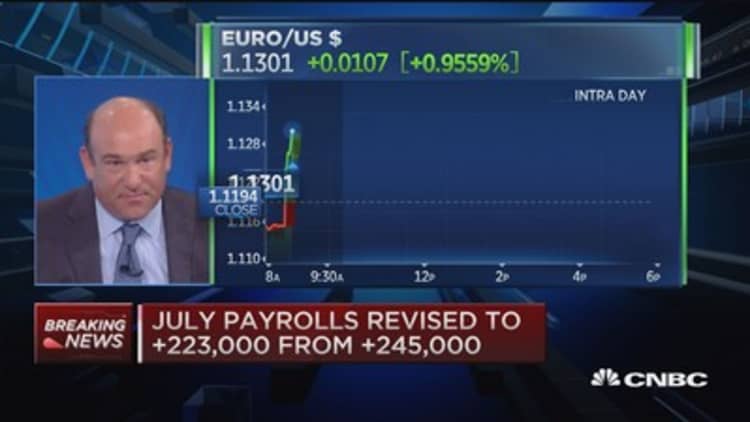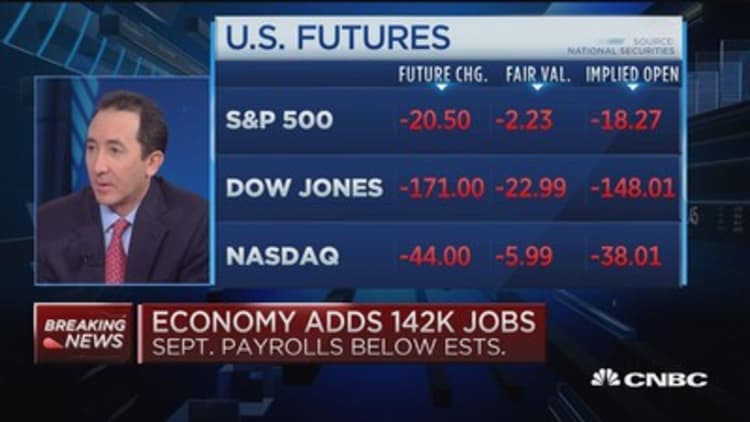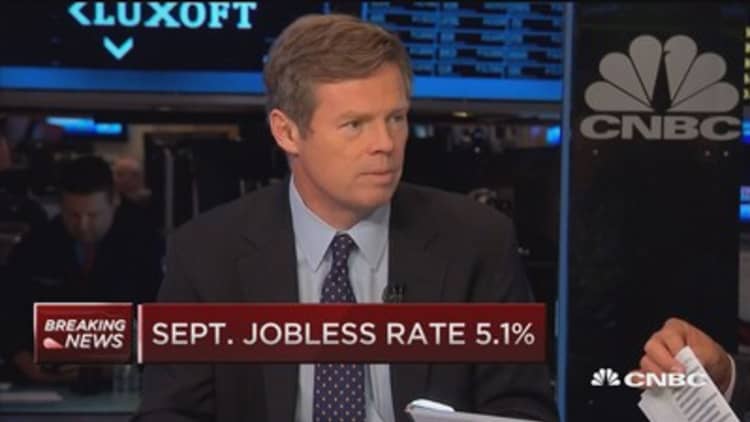


Stocks were rocked Friday and investors ran to the safety of Treasurys after a disappointing jobs report pushed off expectations for a Fed rate hike into 2016 and signaled the U.S. economy may be feeling the impact of weakness overseas.
"This is the shoe we did not expect to drop," said Ward McCarthy, chief financial economist at Jefferies.
The U.S. economy added just 142,000 jobs in September, and the new hires were revised down to 136,000 in August. The unemployment rate stayed unchanged at 5.1 percent but the participation rate fell to 62.4 percent, the lowest since October 1977.
Mid-morning, the Dow and the rebounded from their lows but were still down about 1 percent.
The market immediately shifted the odds of a Fed rate hike into next year, with March at more than 50 percent but the first full rate hike not priced in until the June/July period, according to RBS. Odds for October fell to less than one percent, and December, was at 30 percent, from more than 40 percent.
The Fed held off hiking rates in September because of the potential for international developments hurting the U.S. economy. Since then, weak ISM manufacturing and a sluggish tracking rate for third quarter growth at around 1.7 percent has made economists more concerned.
"This is disappointing all around, not only for September but August. August usually gets revised higher. I can't really find anything good to say about this," said McCarthy. "You had (Boston Fed President Eric) Rosengren saying 2015 liftoff is not unreasonable, but I think the combination of August and September data takes October off the table and raises questions about December, which has been my call for almost two years."
When the Fed held off raising rates, the markets were spooked because it pointed to international developments, meaning weakness in China and emerging markets, as a potential catalyst for weaker U.S. growth. Since then, Fed officials including Fed Chair Janet Yellen, have said the Fed still hoped to raise rates in 2015.
Dow futures Friday instantly reversed a 100-point gain and were negative by 200 points. The 2-year yield, most sensitive to Fed policy, slumped to 0.54 percent, the lowest level since Aug. 24. S&P 500 futures fell more than 1.3 percent, and the dollar weakened.
"Look at the S&Ps, they were up and they have literally dropped like a stone. You're going to have risk markets take a bashing on this. That will support Treasurys," McCarthy said.
Economists had expected 203,000 jobs, and a 0.2 percent rise in hourly wages. Wages were instead flat.
"We had a pretty solid trend on labor at around that 200,000 level. ... We are now two consecutive months of sub-150,000, and that's the first time since 2012," said Ron Sanchez, CIO of Fiduciary Trust. He said the only bright spot was a three-tenths decline to 10 percent in U-6 unemployment, viewed as the real rate by some as it includes the underemployed.
Read More Chart: What's the real unemployment rate?
"There's no doubt you're starting to see a little bit of the fallout effect of slowing emerging market growth, the decline in commodities and the rising dollar. You see it in some of the trade numbers, and you see it in the manufacturing numbers as well," said Sanchez. "You see the consequences of slowing growth overseas."
The weak jobs data also punch a hole in the assumption that the labor market was healthy, enabling the Fed to raise rates while it waits for inflation to rise. The Fed has kept the fed funds target rate at near zero since 2008, and it has not hiked rates in nine years.
"This illustrates how humbling economics is. So I'm humbled right now. I feel like I'm standing in quicksand." said Diane Swonk chief economist at Mesirow Financial. She had expected 220,000 new jobs. "These numbers are consistent with the more recent GDP numbers that we've been looking at which is below 2 percent."
Second quarter GDP growth was revised up, to 3.9 percent, but economists have been cutting back third quarter growth prospects for the past couple of weeks.
Traders were rattled Thursday when ISM manufacturing data came in at 50.2, below the 50.6 expected and just above 50, the number that divides expansion and contraction. But that was offset by a jump in construction spending and a 10-year high in the pace of September vehicle sales.
"These numbers really underscore that if the Fed had moved earlier we'd have been in worse shape today," Swonk said of the jobs data.
Ahead of the report, she noted that the ISM number and lower exports suggest weakness related to China's slowdown. While U.S. trade exposure to China is not great, she said, 29 countries from Australia to Chile and South Korea count on China for more than 20 percent of their exports.
Sanchez said the market will now pick over every piece of data, looking to see whether the slump in growth is just a soft patch imported from overseas or something more enduring.
As for the market, he said the quick drop in bond yields, which move inversely to prices, was a commentary on expectations for the economy. "Growth, not necessarily recessionary; the question is whether this is a little bit of a pause. It has huge implications for the Fed. It pushes that off," he said.
He said the soft U.S. data should slow the dollar's gains, but he sees stocks just experiencing a temporary correction.
"We're still of the opinion that this is a market correction, and not a sustainable bear market," he said.
Peter Boockvar, chief market analyst at economic advisory firm The Lindsey Group, has been looking at the stock market correction as the start of a bear market.
"This proves that the Fed's policy has been a complete failure in generating anything sustainable in terms of growth and job creation," he said.
"It's Fed's policy that, in my opinion, is actually a roadblock to a better economy rather than a facilitator of it."


